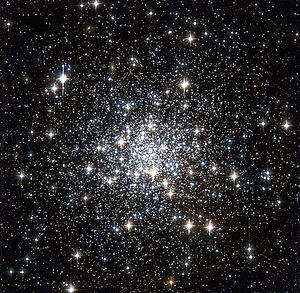NGC 2298
Kugelsternhaufen
NGC 2298 ist ein Kugelsternhaufen im Sternbild Puppis und hat eine Winkelausdehnung von 6′,8 und eine scheinbare Helligkeit von 9,3 mag. Der Kernradius beträgt 16″,3, die Flächenhelligkeit 18,7 mag/arcsec2 [9].
| Kugelsternhaufen NGC 2298 | |
|---|---|
 | |
| Hubble-Aufnahme von NGC 2298 | |
| AladinLite | |
| Sternbild | Achterdeck des Schiffs}} |
| Position Äquinoktium: J2000.0, Epoche: J2000.0 | |
| Rektaszension | 06h 48m 59,2s [1] |
| Deklination | |
| Erscheinungsbild | |
| Konzentrationsklasse | VI [2] |
| Helligkeit (visuell) | 9,3 mag [3] |
| Winkelausdehnung | 5′,0 [4] |
| Physikalische Daten | |
| Zugehörigkeit | Milchstraße (Canis-Major-Zwerggalaxie) |
| Rotverschiebung | +0,000498 ± 0,000004 [5] |
| Radialgeschwindigkeit | (+149,4 ± 1,3) km/s [5] |
| Entfernung | 26960 ± 2470 Lj [6] |
| Absolute Helligkeit | −6,3 mag [7] |
| Durchmesser | 55 Lj |
| Alter | (13,2 ± 0,4) Mia. Jahre [8] |
| Metallizität [Fe/H] | −1,92 [8] |
| Geschichte | |
| Entdeckung | James Dunlop |
| Entdeckungsdatum | 8. Mai 1826 |
| Katalogbezeichnungen | |
| NGC 2298 • C 0647-359 • GCl 11 • ESO 366-SC22 • Dun 578 • GC 1463 • h 3065 | |
Der Sternhaufen wurde am 8. Mai 1826 von James Dunlop entdeckt.[10]
Literatur
Bearbeiten- König, Michael & Binnewies, Stefan (2023): Bildatlas der Sternhaufen & Nebel, Stuttgart: Kosmos, S. 362
Einzelnachweise
Bearbeiten- ↑ NASA/IPAC EXTRAGALACTIC DATABASE
- ↑ Harlow Shapley, Helen B. Sawyer: A Classification of Globular Clusters. In: Harvard College Observatory Bulletin. Band 849, 1927, S. 11–14, bibcode:1927BHarO.849...11S.
- ↑ van den Bergh et al.: "Diameters of Galactic globular clusters"; in: Astrophysical Journal, Vol. 375, S. 594ff. bibcode:1991ApJ...375..594V
- ↑ SEDS: NGC 2298
- ↑ SIMBAD-Datenbank
- ↑ Dinescu et al.: "Space Velocities of Globular Clusters. III. Cluster Orbits and Halo Substructure"; in: The Astronomical Journal, Vol. 117, Issue 4, S. 1792ff. bibcode:1999AJ....117.1792D
- ↑ Forbes et al.: "The Globular Cluster System of the Canis Major Dwarf Galaxy"; in: The Astronomical Journal, Vol. 127, Issue 6, S. 3394ff. bibcode:2004AJ....127.3394F
- ↑ a b M. Salaris, A. Weiss: "Homogeneous age dating of 55 Galactic globular clusters. Clues to the Galaxy formation mechanisms."; in: Astronomy and Astrophysics, Vol. 388, S. 492ff. bibcode:2002A&A...388..492S
- ↑ E. Noyola, K. Gebhardt: "Surface Brightness Profiles of Galactic Globular Clusters from Hubble Space Telescope Images"; in: The Astronomical Journal, Vol. 132, Issue 2, S. 447ff. bibcode:2006AJ....132..447N
- ↑ Seligman